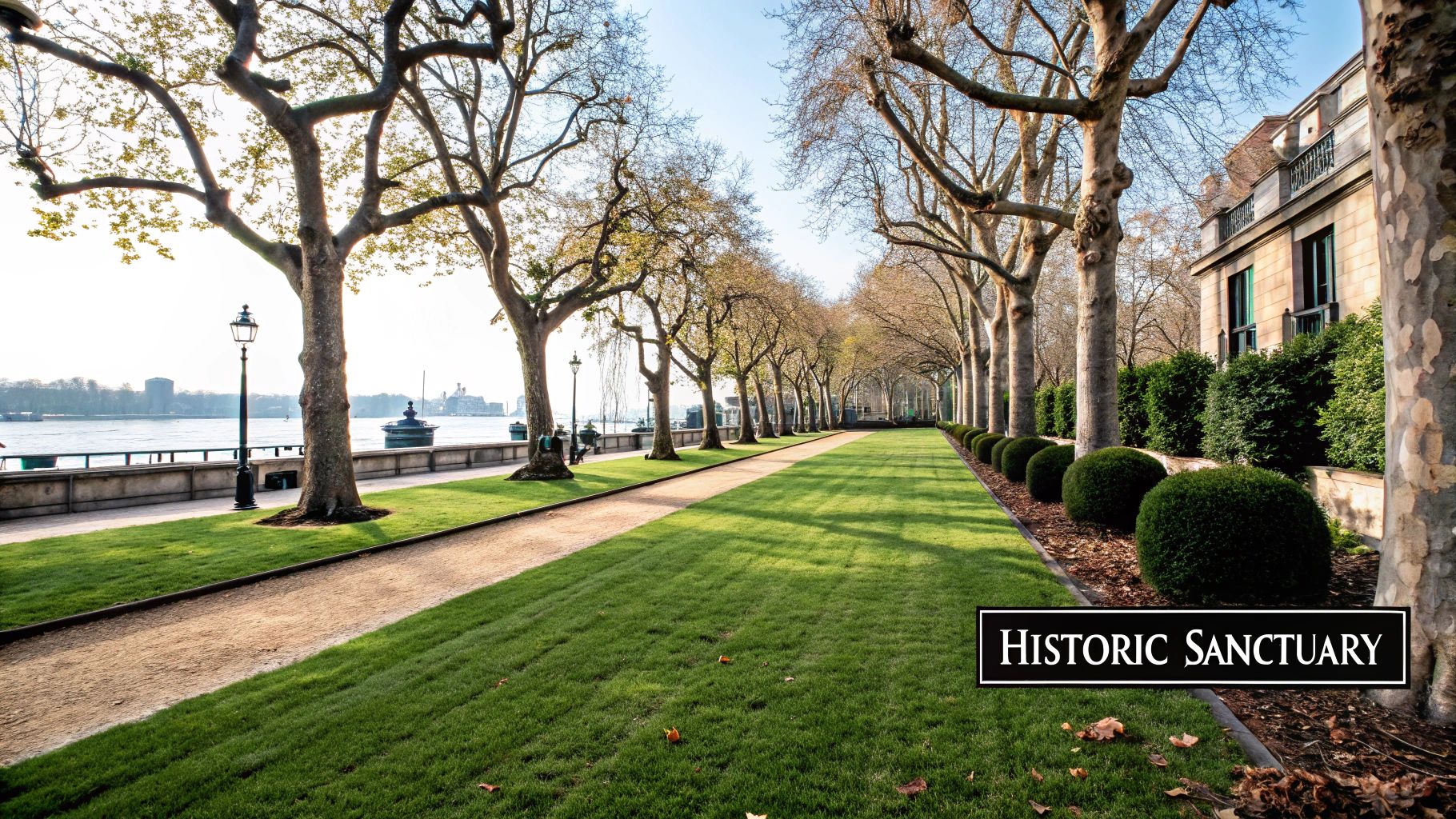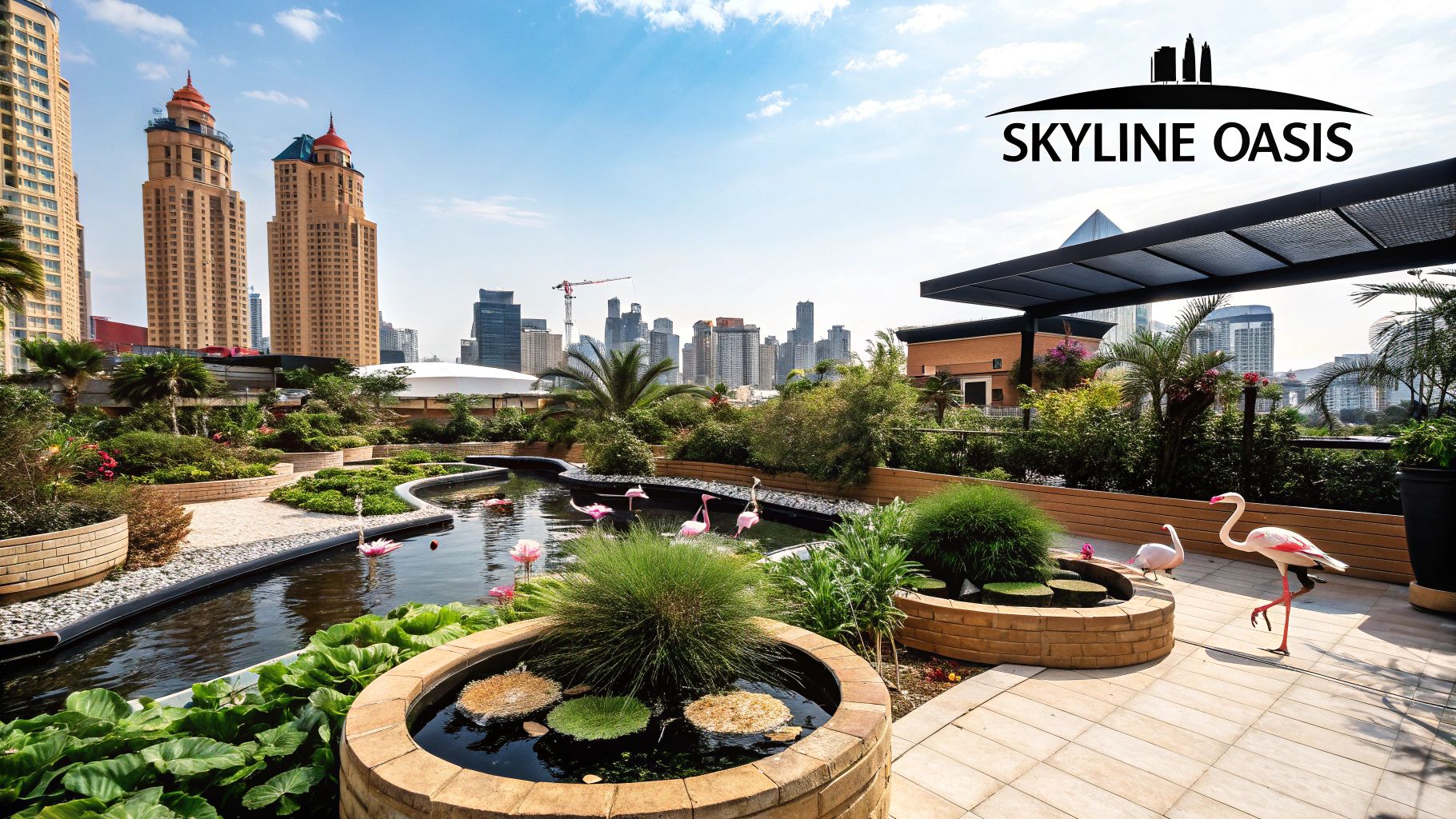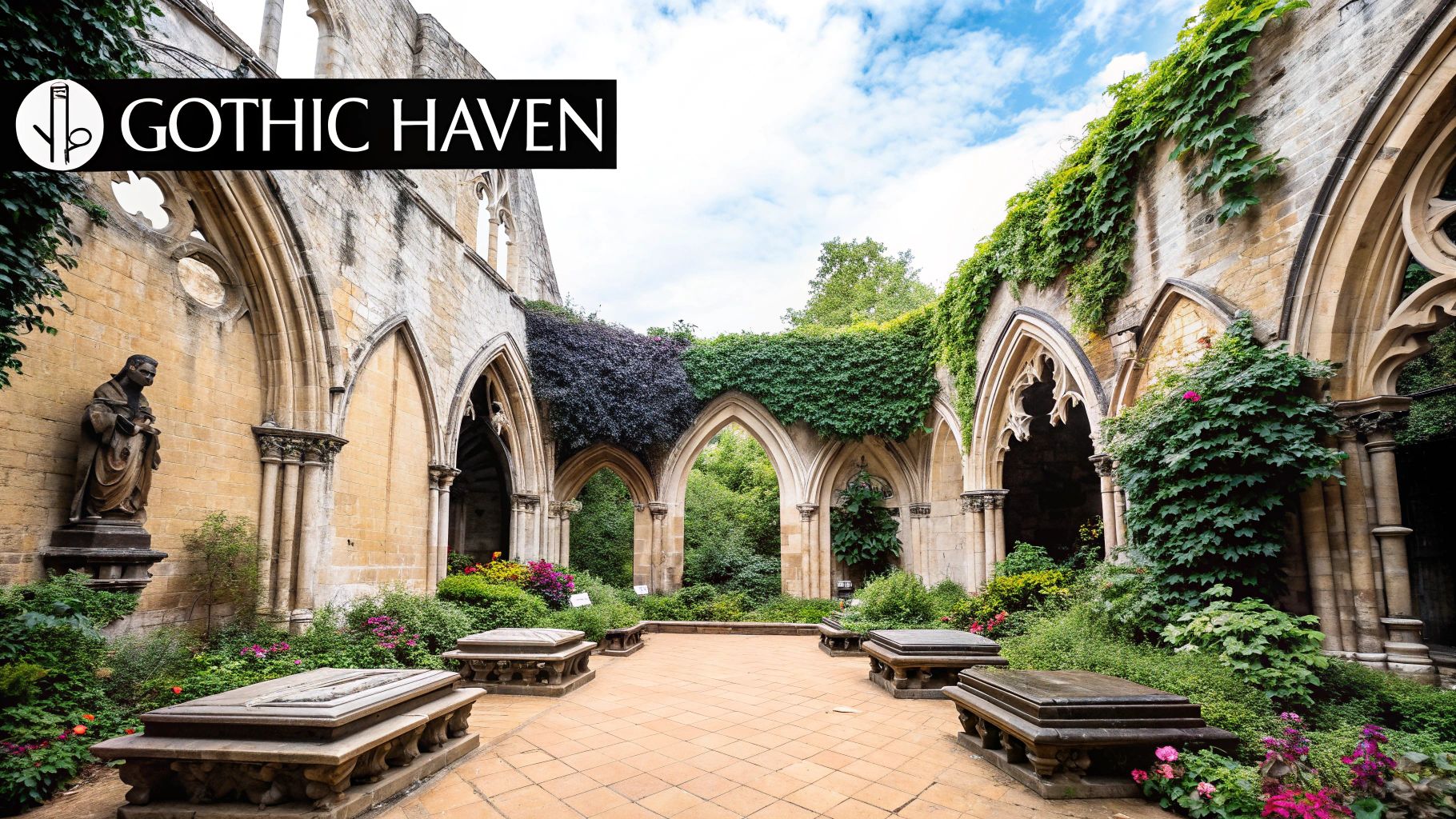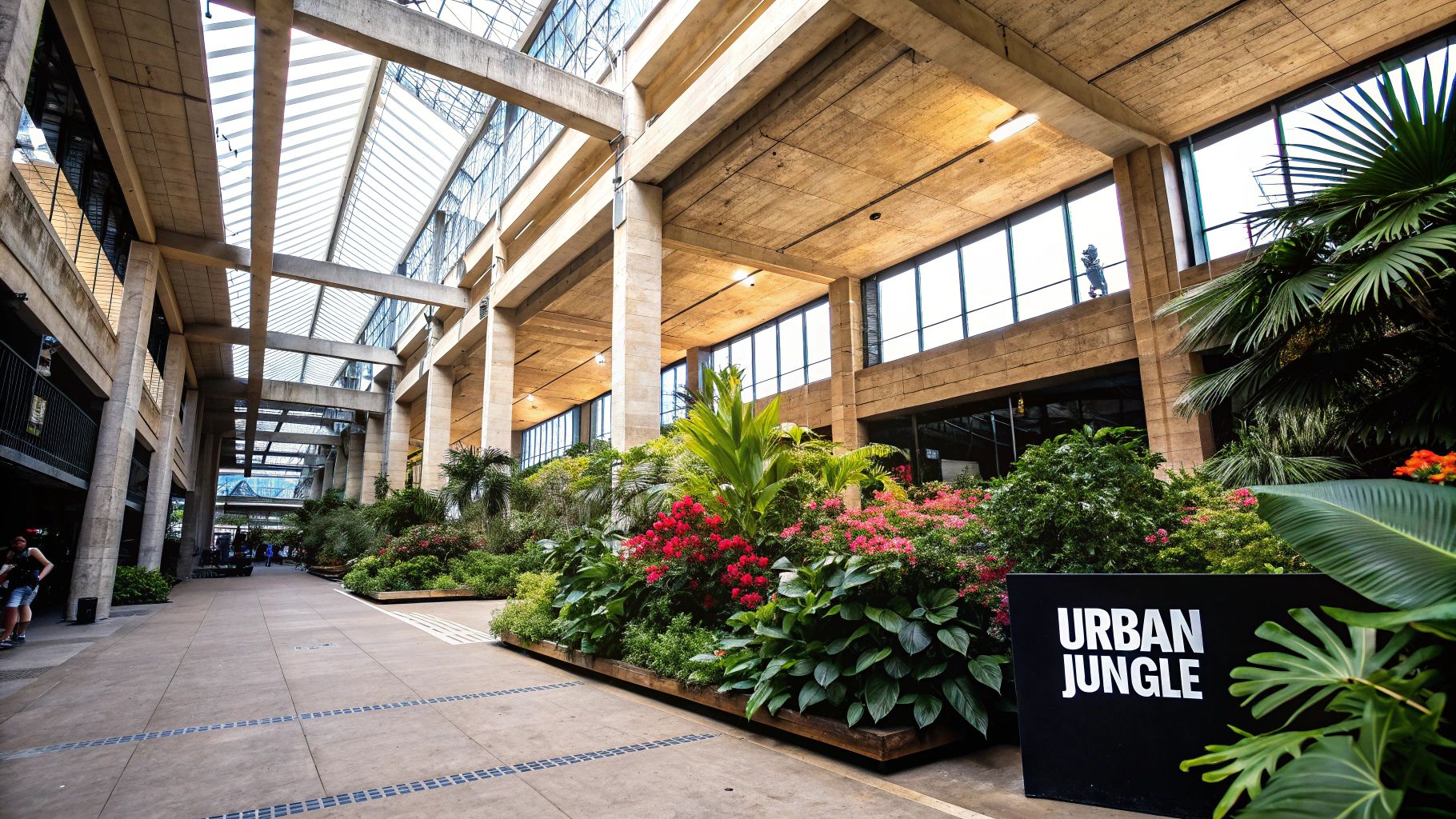7 Hidden Gardens London: Secret City Paradises
7 Hidden Gardens London: Secret City Paradises
Unearthing London's Secret Gardens
Discover seven tranquil escapes from the urban hustle. This listicle reveals London's best hidden gardens, offering peaceful retreats for those seeking a moment of calm. From the historic Inner and Middle Temple Gardens to the rooftop oasis of the Roof Gardens, explore these secret gems perfect for history buffs, nature lovers, and anyone craving a quiet escape. Find your perfect hideaway within London's vibrant tapestry.
1. The Inner and Middle Temple Gardens
Tucked away behind the bustling thoroughfare of Fleet Street, a haven of tranquility awaits: The Inner and Middle Temple Gardens. These hidden gardens in London offer a remarkable escape from the city's frenetic pace, transporting visitors back in time to a world of historic lawns, ancient trees, and vibrant flowerbeds. Dating back to the 13th century, the gardens form part of the historic Inns of Court, the professional associations for barristers in England and Wales, imbuing the space with a unique legal and historical significance. Their secluded location and serene atmosphere make them a true hidden gem, a secret garden in the heart of London waiting to be discovered.

For those seeking a peaceful escape, the Inner and Middle Temple Gardens offer a welcome respite from the busy streets of London. Strolling along the Thames path, which borders the gardens, provides stunning riverside views and a unique perspective on the city. The backdrop of medieval architecture adds to the historic ambiance, creating a sense of stepping back in time.
While the gardens offer a wealth of benefits, including free entry during opening hours, they also have some limitations. Opening hours are restricted to weekdays, with the gardens generally closed on weekends. Furthermore, during lunchtime on weekdays, the gardens can become busy with local workers seeking a midday retreat. Access may also be restricted during private events, so it is always advisable to check the official website for up-to-date opening times and any planned closures.
To make the most of your visit, consider these tips: arrive early in the morning or late in the afternoon to avoid the lunchtime crowds. Access the gardens via Middle Temple Lane or Inner Temple Lane. Combine your visit with a trip to the nearby Temple Church, a historic round church dating back to the 12th century. And finally, remember to check the seasonal opening times before your visit.
The Inner and Middle Temple Gardens represent a unique and valuable green space in the heart of London. They offer not just a visual feast of flowers and historic architecture, but also a palpable connection to the city’s rich past. Whether you are a local seeking a peaceful lunch break or a visitor searching for hidden gardens in London, the Inner and Middle Temple Gardens offer a truly rewarding experience.
2. The Roof Gardens (Virgin Limited Edition)
Discovering hidden gardens in London can lead you to some truly extraordinary places, and The Roof Gardens, formerly owned by Sir Richard Branson, and unfortunately closed now was a prime example. Perched a dizzying 100 feet above the bustling Kensington High Street, this 1.5-acre haven offers a unique escape from the urban sprawl below. Created in the 1930s, this rooftop paradise was a testament to imaginative design and offers a blend of nature, history, and stunning city views that set it apart from other hidden gardens London has to offer.

The Roof Gardens' unique appeal lied in its three distinct themed gardens: the Spanish Garden, with its Moorish-inspired fountains and fragrant orange trees; the Tudor Garden, a tranquil space evoking a classic English knot garden; and the English Woodland, a surprisingly wild escape complete with streams, rustic bridges, and even resident flamingos. This diverse horticultural collection boasted over 500 species of plants and trees, creating a vibrant tapestry of colours and textures. Beyond the flora, the fauna also played a starring role. The flamingos were undoubtedly the main attraction, but you would have also found other exotic birds and fish adding to the lively atmosphere. Ornamental ponds and water features enhanced the tranquil ambience, making this a truly multi-sensory experience.
The Roof Gardens offered a 360-degree panorama of the London skyline, providing a unique elevated perspective of the city. This breathtaking backdrop combined with the historic Art Deco architecture of the building created stunning photography opportunities. Imagine capturing the sunset over the London Eye with a flamingo gracefully wading in the foreground – truly a unique memory to cherish. It’s no wonder this venue became a favourite for high-end fashion shoots, celebrity weddings, and exclusive corporate events.
While The Roof Gardens were a spectacular hidden gem amongst London's gardens, access wasn't always straightforward. Public access was often limited, requiring advance booking, which was essential to avoid disappointment.
The experience was also weather-dependent, with spring and summer offering the most vibrant plant displays and optimal outdoor enjoyment. The onsite restaurant offered a route to guaranteed access - though at a premium price point. Finally, be aware that photography was restricted in some areas.
For those seeking a truly unique experience, a visit to The Roof Gardens was highly recommended. Booking well in advance, particularly during peak seasons, was crucial for securing your spot. If visiting during spring or summer, it was advised to consider making dining reservations for guaranteed entry and a luxurious experience. Don't forget your camera to capture those unique London skyline shots framed by the gardens' extraordinary flora and fauna.
The Roof Gardens earned its place on this list of hidden gardens in London due to its unique combination of features. The diverse themed gardens, the surprising wildlife, and the breathtaking city views make it an experience unlike any other. It was a place where nature met urban sophistication, offering a tranquil escape while still being in the heart of London. While there were limitations regarding access and cost, the extraordinary beauty and unique perspective this hidden gem offered made it well worth the effort. The influence of Sir Richard Branson and the many celebrities who have graced this venue only adds to its allure. Learn more about The Roof Gardens (Virgin Limited Edition)
3. St. Dunstan-in-the-East Church Garden
Tucked away amidst the bustling streets of the City of London lies a hidden gem, a secret garden where history and nature intertwine. St. Dunstan-in-the-East Church Garden is not your typical green space; it's a hauntingly beautiful sanctuary built within the ruins of a medieval church, offering a unique and tranquil escape from the urban clamor. This extraordinary space has earned its place among London's hidden gardens for its captivating blend of history, architecture, and natural beauty, making it a must-see for anyone seeking a moment of peace and wonder in the heart of the city.

The story of St. Dunstan-in-the-East begins in the Middle Ages. The original church, dating back to the 12th century, served the community for centuries. Tragically, during the devastating London Blitz of World War II, the church was severely damaged. While the towering steeple designed by the renowned architect Sir Christopher Wren survived, much of the church was left in ruins. Instead of demolishing the remnants, a visionary decision was made to transform the bombed-out shell into a public garden. In 1967, the City of London officially opened St. Dunstan-in-the-East Church Garden, creating a poignant memorial and a truly unique urban oasis.
Today, the garden flourishes within the skeletal remains of the church. Ivy climbs the weathered stone walls and drapes over the Gothic arches, creating a romantic and almost mystical atmosphere. Subtropical and temperate plants thrive in the sheltered microclimate, providing year-round colour and interest. Peaceful seating areas nestled amongst the ruins invite visitors to pause and reflect amidst this extraordinary fusion of nature and history.
St. Dunstan-in-the-East offers a wealth of features that contribute to its unique charm. The ivy-clad medieval walls and arches provide a dramatic backdrop, while Wren's surviving tower offers a glimpse into the church's past. The diverse plant collection, ranging from ferns to flowering shrubs, creates a sense of vibrant life within the ancient ruins. The garden also offers exceptional photography opportunities, capturing the interplay of light and shadow on the weathered stone and lush greenery.
One of the major advantages of this hidden garden is that it's completely free and open to the public. Its central location, close to the Tower of London and Tower Bridge, makes it easily accessible for both Londoners and tourists. It offers a peaceful escape from the city's hustle and bustle, a place to find tranquility amidst the historical heart of London. It's beautiful in all seasons, offering a different perspective with each changing season, from the vibrant greens of spring and summer to the warm hues of autumn and the stark beauty of winter.
While St. Dunstan-in-the-East offers a unique and rewarding experience, there are a few potential drawbacks to consider. Its popularity, particularly amongst photographers and social media influencers, means it can get crowded, especially during peak times. Its limited size can make it feel busy, particularly during weekends or holidays. Also, there are no on-site facilities such as toilets or a café. Be aware that some areas can become slippery when wet, especially the mossy stone steps.
If you're planning a visit to St. Dunstan-in-the-East, here are a few tips to enhance your experience. Visiting early in the morning offers the best light for photography and allows you to enjoy the tranquility before the crowds arrive. Bring your camera – this hidden garden is incredibly photogenic. Combine your visit with a stroll along the nearby Thames Path for a longer exploration of the area. Finally, be sure to check the seasonal opening hours before your visit.
St. Dunstan-in-the-East Church Garden stands as a testament to London's resilience and its ability to transform tragedy into beauty. This "hidden garden" isn't just a green space; it's a living embodiment of history, a captivating blend of nature and architecture, and a truly unique destination amongst London's hidden treasures. It deserves its place on any list of hidden gardens London has to offer, providing a unique and unforgettable experience for those who venture within its ancient walls.
4. Postman's Park
Tucked away amidst the towering buildings and bustling streets of the City of London, lies a tranquil oasis known as Postman's Park. This hidden gem, a small but deeply moving space, offers a unique escape from the urban frenzy. It’s more than just a green space; it's a poignant tribute to everyday heroism and a fascinating glimpse into Victorian social history, securing its place as a must-visit among London's hidden gardens. Established in 1880 from three former churchyards, Postman's Park provides a peaceful sanctuary and a powerful reminder of the unsung heroes among us.

The park's most distinctive feature is the Memorial to Heroic Self Sacrifice. Conceived by the Victorian artist George Frederic Watts, this extraordinary memorial consists of a wall adorned with over 50 ceramic plaques. Each plaque commemorates an ordinary individual who lost their life while saving another, acts of bravery often overlooked by official recognition. The stories etched onto these plaques range from dramatic rescues from burning buildings and drowning incidents to simpler, yet equally courageous acts of selflessness. Reading through these accounts offers a powerful and moving experience, connecting visitors with a tangible piece of social history and the human capacity for extraordinary courage.
Postman's Park represents a unique blend of historical significance and urban tranquility. Mature trees and traditional garden plantings create a serene atmosphere, offering a welcome respite from the concrete jungle that surrounds it. Bench seating scattered throughout the park invites quiet contemplation and reflection amidst the rustling leaves and birdsong. Its small, well-designed layout allows for easy navigation, ensuring that every corner of this hidden garden is accessible and inviting. The park's historic churchyard setting adds another layer of intrigue, whispering tales of London's past. You can learn more about Postman's Park from other sources as well, delving deeper into its fascinating history and the stories it holds.
While the park's small size is a boon for creating a sense of intimacy, it can also lead to a feeling of crowdedness during peak times. Its proximity to towering office buildings can sometimes overshadow the space, and the emotionally heavy content of the memorial might not resonate with everyone. However, the overall experience remains profoundly unique. The combination of tranquil beauty and poignant remembrance creates an atmosphere unlike any other in London.
For those seeking a moment of quiet reflection, a dose of history, or a unique escape from the urban hustle, Postman’s Park is an ideal destination. Its free accessibility and central location, near St. Paul's Cathedral, make it an easy addition to any London itinerary. Consider visiting during lunch hours to observe City workers enjoying a peaceful break or bringing a book to enjoy some quiet reading time. The park is also a popular spot for history enthusiasts and researchers drawn to the stories of ordinary heroism commemorated within its walls. The film 'Closer' (2004), featuring Julia Roberts, brought wider attention to the park, highlighting its unique atmosphere and emotional resonance.
Tips for your visit:
- Take your time to read the memorial plaques carefully. Each one tells a compelling story of courage and sacrifice.
- Visit during quieter periods, perhaps early morning or late afternoon, for a more contemplative experience.
- Combine your visit with a trip to nearby St. Paul's Cathedral for a full day of historical exploration.
- Consider bringing a notebook and pen to jot down reflections or interesting details from the memorial plaques.
- If you're exploring the Kings Cross area, you might find some interesting connections. Learn more about Postman's Park
Postman's Park offers something truly special amidst the sprawling metropolis of London. It’s a testament to the power of quiet spaces, the importance of remembering unsung heroes, and the enduring allure of hidden gardens within our bustling cities. This hidden garden in London provides a powerful reminder of the strength of the human spirit and the beauty of selflessness in a world often focused on personal gain. It deserves its place on any list of must-visit hidden gardens in London, offering a unique and unforgettable experience.
5. Chelsea Physic Garden: A Hidden Oasis of Medicinal History
Tucked away behind high walls in the heart of Chelsea lies a secret garden, a verdant sanctuary teeming with history and horticultural wonders. While London boasts many beautiful green spaces, the Chelsea Physic Garden stands apart, earning its place on this list of hidden gardens not just for its secluded location, but also for its unique character and rich heritage. If you're seeking a tranquil escape with a fascinating backstory, this four-acre haven offers a captivating blend of beauty, education, and historical significance, making it a must-visit for anyone interested in botany, medicine, or simply a peaceful afternoon amidst nature.
Founded in 1673 by the Worshipful Society of Apothecaries, the Chelsea Physic Garden is London's oldest botanic garden after Oxford. Originally designed as a training ground for apprentice apothecaries to identify medicinal plants, it has evolved into a living museum housing over 5,000 different edible, useful, medicinal, and historical plant species. This remarkable collection offers a glimpse into the vital role plants have played in medicine and human history for centuries. Imagine strolling through meticulously curated beds, discovering the origins of everyday remedies and marveling at the diversity of the plant kingdom.
One of the garden’s most remarkable features is its unique microclimate. Nestled beside the Thames and enclosed by high walls, the garden enjoys a sheltered environment that allows exotic plants to flourish in London. This allows visitors to encounter species they wouldn't typically see in the UK, from towering palms in the greenhouse complex to medicinal herbs used in traditional remedies. The garden’s historic design, dating back to 1673, adds another layer of charm. The layout and architecture reflect the garden's original purpose, providing a tangible connection to the past.
The Chelsea Physic Garden offers a wealth of experiences beyond simply admiring the flora. Expert-led tours delve deep into the garden’s history and the fascinating stories behind specific plants. You can discover how cotton seeds cultivated here played a crucial role in establishing the US cotton industry, or how tea plants from this very garden were sent to India, forever changing the global tea trade. The garden also hosts workshops and educational programs, catering to both novice gardeners and seasoned horticulturalists. For those seeking a quieter experience, the peaceful atmosphere and garden views make it an ideal spot for contemplation and relaxation. The excellent on-site café provides a delightful setting to enjoy refreshments amidst the tranquil surroundings.
While the Chelsea Physic Garden offers numerous advantages, it's important to consider a few practicalities. There is an admission fee, though it's reasonable considering the garden’s upkeep and educational value. Opening hours are limited and subject to seasonal closures, so be sure to check their website before your visit. Also, being a specialized garden focused on useful and medicinal plants, its aesthetic might be less vibrantly colourful than a purely ornamental garden. Its relatively small size can also lead to a crowded feel during peak times, particularly weekends and school holidays.
To make the most of your visit, consider booking a guided tour for maximum educational benefit. Exploring the garden with an expert provides invaluable insights into the plants’ history, uses, and significance. Visiting during different seasons also allows you to experience the varied collections in their prime. Check their event calendar for special exhibitions, workshops, and other activities that might pique your interest. Allow at least 2-3 hours for a thorough visit to fully appreciate the garden’s extensive collection and historical context.
The Chelsea Physic Garden’s legacy is intertwined with influential figures like Sir Hans Sloane, a key patron and protector who helped shape its development. The Worshipful Society of Apothecaries’ ongoing involvement ensures the preservation of its historic mission. The work of numerous botanists and plant hunters continues to enrich the garden's diverse collections. This garden continues to be a vital hub for research, collaborating with major pharmaceutical companies and offering educational programs for medical students.
Whether you’re a seasoned gardener, a history enthusiast, or simply seeking a tranquil escape from the urban hustle, the Chelsea Physic Garden offers a unique and rewarding experience. Discover a hidden oasis of botanical wonders and explore a living testament to the power and beauty of the plant kingdom. Learn more about Chelsea Physic Garden nestled in the heart of one of London's most charming boroughs. This hidden gardens London gem is waiting to be explored.
6. Barbican Conservatory: A Tropical Escape in the Heart of the City
Seeking a hidden oasis amidst the urban sprawl? Look no further than the Barbican Conservatory, a verdant jewel tucked away within the Brutalist concrete landscape of the Barbican Centre. This extraordinary space earns its place on our list of hidden gardens London has to offer, providing a unique and unexpected escape into a tropical paradise, right in the heart of the city. Forget bustling streets and grey skies; within these walls, you'll find a vibrant world of lush foliage, exotic wildlife, and a tranquil atmosphere that feels miles away from the urban jungle outside.
Opened in 1984, the Barbican Conservatory is London's second-largest conservatory, spanning the length of a city block. It houses over 2,000 species of tropical plants and trees, arranged across two distinct climate zones, creating a diverse and fascinating display. From towering palms and vibrant ferns to delicate orchids and cacti, the sheer variety of flora is astonishing. This carefully curated collection allows visitors to experience the beauty and diversity of tropical ecosystems without ever leaving London.
The conservatory’s design is particularly striking. The juxtaposition of the lush, vibrant vegetation against the stark, geometric concrete of the Barbican Centre creates a dramatic and unforgettable visual contrast. The natural light streaming through the conservatory’s glass roof illuminates the plants, highlighting their textures and colours, while the Brutalist architecture provides a unique and unexpected backdrop. This blend of nature and architecture is truly one-of-a-kind and makes the Barbican Conservatory stand out among London's hidden gardens.
Beyond the botanical wonders, the conservatory is also home to a variety of exotic wildlife. Keep an eye out for the resident terrapins basking in the warmth, watch colourful tropical fish darting through the ponds, and listen for the calls of exotic birds hidden amongst the foliage. These additions further enhance the tropical atmosphere and offer a delightful element of surprise for visitors.
The Barbican Conservatory offers a range of benefits for Londoners and visitors alike. Free admission makes this world-class conservatory accessible to all, providing a welcome respite from the often-expensive attractions of the capital. The warm, tropical environment is a welcome escape year-round, offering a sunny retreat even on the dreariest of London days. Furthermore, the conservatory is a fantastic destination for families, offering an educational and engaging experience for children and adults alike. The unique combination of architecture and horticulture also makes it a haven for photographers, botany students, and anyone seeking a bit of tranquility and inspiration.
However, there are a few things to consider when planning your visit. The conservatory has limited opening hours, primarily on weekends and some weekdays, so checking the Barbican Centre website ([insert website link here]) beforehand is essential. Advance booking is required for weekend visits, especially during peak seasons, so plan ahead to avoid disappointment. Due to its tropical environment, the conservatory can get very humid and warm, so dressing in light clothing is recommended. Finally, be aware that photography restrictions may apply in certain areas.
Despite these minor drawbacks, the Barbican Conservatory is undoubtedly a hidden gem worth discovering. It has become a popular venue for unique wedding photography, educational visits for botany students, a location for art installations and events, and a subject for architectural photography exhibitions, demonstrating its versatility and appeal. The conservatory’s popularity is in part due to the vision of Chamberlin, Powell and Bon, the original Barbican architects, and the continued efforts of the Barbican Centre programming team to showcase this remarkable space.
To make the most of your visit, we recommend booking weekend visits well in advance online. Wear light clothing as the internal temperature can be quite high. Weekday mornings generally offer a less crowded experience, allowing for a more leisurely exploration of the conservatory. Combine your visit with one of the many concerts, films, or exhibitions hosted at the Barbican Centre for a truly enriching day out. For anyone looking for hidden gardens London has to offer, the Barbican Conservatory provides an unforgettable escape into a tropical paradise.
7. Fenton House Garden: A Secret Slice of 17th-Century Charm in Hampstead
Tucked away in the heart of Hampstead, Fenton House Garden offers a captivating escape from the bustling city, a true hidden gem amongst London's green spaces. This meticulously preserved 17th-century formal garden, attached to a merchant's house of the same era, provides a tranquil oasis and a fascinating glimpse into horticultural history. For those seeking hidden gardens London has to offer, Fenton House presents a unique blend of historical significance, natural beauty, and captivating views.
Fenton House Garden is a testament to the enduring appeal of formal garden design. Geometric box hedging creates structure and symmetry, shaping the garden into distinct "rooms" and providing a verdant backdrop for colourful seasonal displays. Immaculately trimmed topiary adds further architectural interest, showcasing the skill and dedication of the gardeners who maintain this historical landscape. The garden’s design is a model for other National Trust historic garden restorations, providing inspiration for contemporary gardeners and demonstrating the elegance and practicality of 17th-century principles.
Beyond its formal elements, Fenton House Garden boasts a remarkable collection of heritage apple trees. This orchard, featuring historic varieties rarely seen today, offers a delicious sensory experience, particularly during the apple blossom season in April and May. The sight and scent of the blossoming trees are truly enchanting, making it a prime time for photography and quiet contemplation. This aspect of the garden is particularly popular with heritage craft and gardening enthusiasts and has been featured in numerous period garden design publications.
The garden’s charm extends beyond ornamental features. A traditional kitchen garden provides a practical counterpoint to the formal areas, showcasing traditional methods for growing vegetables and herbs. This working garden serves as an educational resource for garden history students and offers visitors a tangible connection to the past, illustrating how such gardens provided sustenance and medicinal resources for households centuries ago.
The elevated location of Fenton House in Hampstead adds another layer of appeal to this hidden garden. While enveloped in the tranquil atmosphere of a country estate, glimpses of the London skyline peek through the foliage, reminding visitors of the city's proximity while simultaneously offering a sense of escape. This unique juxtaposition contributes to the garden’s magical quality, creating a space that feels both secluded and connected to the wider urban landscape.
Fenton House Garden’s authentic period experience, beautiful seasonal displays, and peaceful Hampstead village setting make it a worthwhile destination. The excellent preservation of historical gardening methods further enhances its value, particularly for those interested in garden history. Combining a visit to the garden with a tour of the house offers a comprehensive insight into 17th-century life and is highly recommended. Lady Binning, a 20th-century owner, played a crucial role in preserving the garden, ensuring its survival for future generations to enjoy.
While the National Trust admission fees apply, the experience offered by Fenton House Garden justifies the cost. National Trust members, of course, benefit from free entry. It's worth noting that the garden operates on limited opening hours, primarily focusing on weekends and the peak season, so planning your visit is essential. The garden is also smaller in scale than major public gardens, making it ideally suited to those seeking a more intimate and less crowded experience. However, it can get busy during peak National Trust visiting times, particularly during school holidays and weekends.
For the best experience, consider visiting during the apple blossom season (April-May) for a spectacular display. Combining your visit with a walk on nearby Hampstead Heath further enhances the experience, offering more opportunities to explore the natural beauty of the area. Checking the National Trust website ([insert link to Fenton House page on National Trust website here]) for opening hours and special events is crucial before planning your visit. Timing your visit to coincide with the house opening hours allows for a richer and more complete experience, providing context to the garden’s history and significance.
Fenton House Garden is more than just a green space; it’s a living testament to horticultural history, offering a tranquil escape and a fascinating glimpse into the past. For those seeking hidden gardens London offers, this gem in Hampstead deserves a prominent place on your list.
Comparison of 7 Hidden Gardens in London
Embrace the Tranquility: Your London Garden Escape Awaits
From the historic serenity of the Inner and Middle Temple Gardens to the vibrant rooftop oasis of The Roof Gardens, this journey through London's hidden gardens has revealed a wealth of tranquil escapes. Whether you're drawn to the ancient ruins of St. Dunstan-in-the-East Church Garden, the poignant memorials of Postman's Park, the botanical wonders of Chelsea Physic Garden, the tropical warmth of the Barbican Conservatory, or the charming elegance of Fenton House Garden, these secret havens offer respite from the urban bustle. Discovering these hidden gardens London allows you to connect with nature, history, and a quieter side of this vibrant city. These pockets of peace offer a valuable opportunity to recharge and reflect, enriching any London experience.
Stepping away from the well-trodden paths to explore these hidden gems adds a unique dimension to your visit. These special locations are perfect for a quiet afternoon with a book, a romantic stroll, or simply a moment of peaceful contemplation. Exploring London's hidden gardens offers an unforgettable experience, blending natural beauty with historical charm.
Ready to weave these enchanting hidden gardens London into your perfect London itinerary? Let Gone Sun Where curate an unforgettable experience, combining these serene escapes with the best of luxury lifestyle, fashion, dining, and more. Visit Gone Sun Where to start planning your bespoke London adventure today.





